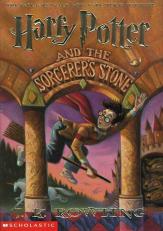 Title: Harry Potter and the Sorcerer’s Stone
Title: Harry Potter and the Sorcerer’s Stone
Author: J.K. Rowling
ISBN: 978-0590353427
Publication Date: 1999
Genre: Fantasy
Reading Level/Interest Age: 12 and up
Plot: Harry Potter has lived with Dursley family, who does not give Harry the same respect as they do to their son, Dudley. Harry has yet to learn that he has been accepted into the Hogwarts Academy to master the art of magic. The Dursley’s do not like this and prevent Harry from finding out about his acceptance and move to a small distant island. Of course, this will not stop the school from informing Harry and so Rubeus Hagrid – half giant and half man – bursts in and proposes the opportunity for Harry to attend the academy. Once Harry accepts, he meets his soon to be long term friends, Rob Weasley and Hermione Granger, and travel through the Platform 9 3/4 where the train will transport them to the Hogwarts. As Harry and his friends enter this wizarding world, there is so much to learn about magic and how powerful and dark it can be.
Critical Evaluation: This particular is the first book of the popular Harry Potter series. Rowling does an amazing job at the descriptive detail on explaining the realm of magic to the reader. The Sorcerer’s Stone opens this new world to the reader and prepares the audience of the next adventures that awaits. Readers of all ages can enjoy reading these well written novels because everyone’s imagination will run wild with exciting adventures that they will embark upon with the three clever wizards.
Reader’s Annotation: Harry is introduced to the wizarding world at Hogwarts academy, which will start his magical journey to new adventures.
Author: Retrieved from Biography in Context –
J. K. Rowling was born Joanne Rowling on July 31, 1965, in Chipping Sodbury, a small town near Bristol, England, the daughter of a French-Scottish mother named Anne, and a Rolls Royce engineer father named Peter Rowling, who met on a train leaving King’s Cross Station in London. She also has one older sister, Diana. In 1971 the Rowlings moved to nearby Winterbourne, in Bristol, and among the children’s friends were Ian and Vikki Potter. Three years later, the family moved again, to Tutshill, near the border of Wales.
Rowling says she started writing stories at age six. Her first story, Rabbit, was about a rabbit with measles. Rowling later described herself as a child to a January Online interviewer as much like Harry Potter: “short, squat,” wearing thick glasses, shy, “very bossy” and “very bookish,” though “terrible at school.” She said she was “never happier than when reading or writing.”
Rowling studied French at Exeter University and earned a bachelor’s degree in 1986. After graduation she worked as a secretary at various firms, including a publisher, where part of her job was writing and sending out rejection letters to prospective authors. Her dream was still to become a writer, and she started several adult novels but never finished them. In 1990 Rowling first imagined Harry Potter while on a train that was delayed for hours between Manchester and London and has noted that the character emerged to her “fully formed.”
Rowling moved to Portugal in 1990 to teach English, and there she met and married Portuguese television journalist Jorge Arantes, with whom she had a child, Jessica. Unfortunately, the marriage ended in divorce after a stormy two years marked by frequent quarreling. Although Rowling has denied basing her arrogant, lying wizard Gilderoy Lockhart on Arantes, she had noted that the character in the Harry Potter series was modeled on a real person who was “even more objectionable than his fictional counterpart.”
Curriculum Ties: N/A
Booktalking Ideas: N/A
Challenging Issues:
- Religious viewpoints
Defensive Maneuvers:
- I would be sure to study and memorize the library’s collection policy.
- The Library Bill of Rights must also be brought to the challenger’s attention stating that the library is an information institution that provides both information and ideas.
- Have both good and bad reviews (from respected sources) about the book at hand.
- Remember to mention the awards and honors that the item has received.
- Be sure to listen to the person who is challenging the book and do not interrupt them while they are speaking. Try to understand where the patron is coming from when he or she states their concerns about the material.
- When you respond to the challenger, have a calm and respectable tone informing them that the library must do all that it can to provide intellectual freedom to its patrons, young and old.
Why This Book? I have always loved this series and I can never put them down.
